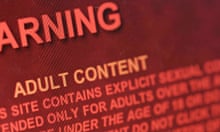The growing number of internet users stumbling upon images of child sex abuse indicate that child sex abuse is not so far removed from the glamorised world of adult pornography. In fact, I would argue, it is part of its continuum.
In decades gone by, particular sexist attitudes were contained by national cultures’ boundaries. Today, under advanced globalisation, those boundaries are less clear. Pornography requires no translation, no explanation and no particular vernacular. It is a universal language, and it can also serve as a training ground for abuse.
An astounding amount of pornographic films include violent acts toward women. In 2010, research estimated 88% of the most popular porn videos depicted violence against women. And while the public is horrified pick up artist Julien Blanc forces women’s faces into his crotch, those very same activities are defended as choice, liberation and “free speech” in pornography.
Users may see a vast difference between adult consensual sex and the illegal use of underaged actors, but buyer preference for very young women sets the scene for sexual abuse. At the age of 18, exploited children supposedly become free and willing adult workers. This is a dangerously blurred line given the “teen” genre remains the most sought after porn – how can users be sure porn actors really are willing adults?
Unfortunately, the link between porn and wider exploitation is rarely discussed. It is evident that the western “consumer choice” to watch pornography may restrict or violate the rights of others, but many prefer to look the other way.
Mexican journalist Lydia Cacho’s investigations found that sex traffickers use the choice rhetoric to justify their trade: “difficult choices are still choices”, said one child sex trafficker in Asia. The “choice” available to a middle class American woman to work on the sex industry is inapplicable to those from a deeply collectivist culture, embedded in systems of poverty and familial responsibility. Yet, by focusing on the privileged few who put forward their agency and free will to engage in the industry, we marginalise the majority who have none. More worryingly, Cacho’s investigations revealed that traffickers also use the idea of western sexual liberation and choice to groom girls. Just consider what Cacho explained in this interview:
In Cambodia, Cacho met a woman who runs a brothel who explained how she ‘reprograms’ girls by ‘normalising sexual exploitation through systematic exposure to pornography. They have to be convinced that they were the ones who chose to do this, and they must be constantly reminded that their lives are worth nothing.’
Some UN member states estimate between 60-90% of women in the sex trade are trafficked. Thai estimates show 40% of the sex trade is child sex abuse and around 90% of trafficked girls are underage. Indigenous women are also highly overrepresented in areas of the trade. Global inequality has long encouraged sexual exploitation, but only recently has it been broadcast in pornography. How many of these women feature on porn movies watched across the world? Research suggests users do not care.
Criticism of such issues may be framed as “anti sex”, or against those working in the trade. On the contrary, the western choice rhetoric may legitimise exploitation of the economically vulnerable. Arguments for choice, agency or “feminist porn” create new opportunities to expand sales, rather than ethics. Users draw upon piecemeal evidence to argue the sex industry can actually reduce sexist attitudes and violence. This goes directly against 2010 meta-analysis, most recent experimental evidence and Nordic state legislation review showing the opposite.
The scale of the sex trade obscures its harms and makes it impossible to deal with. Developing economies have neither the resources nor the structural integrity required to indict child sex abusers. With the exception of a few Nordic states, the customer can purchase sex anywhere in the world. Entire websites are dedicated to informing “sex tourists” on how to best exploit girls and women in any country. Meanwhile, the laws against trafficking remain fragmented:Australia, for example, only implemented legislation in 2005.
Left leaning sex trade supporters commonly argue that all industries are exploitative under capitalism, so the sex industry is like any other. Those who survive the industry tell a different story. That the degradation and life long pain is incomparable, unquantifiable and unimaginable, the suffering continually recurs as their abuse may be trafficked on film around the world, over and over. The rates of PTSD experienced by survivors of the sex trade, being equal to those of war veterans, attest to this.
Consumers need to take off the porn coloured glasses and critique the industry for what it is – a global trade in human rights abuses. What use is confronting Julien Blanc if a global economy of misogyny goes on condoned?







